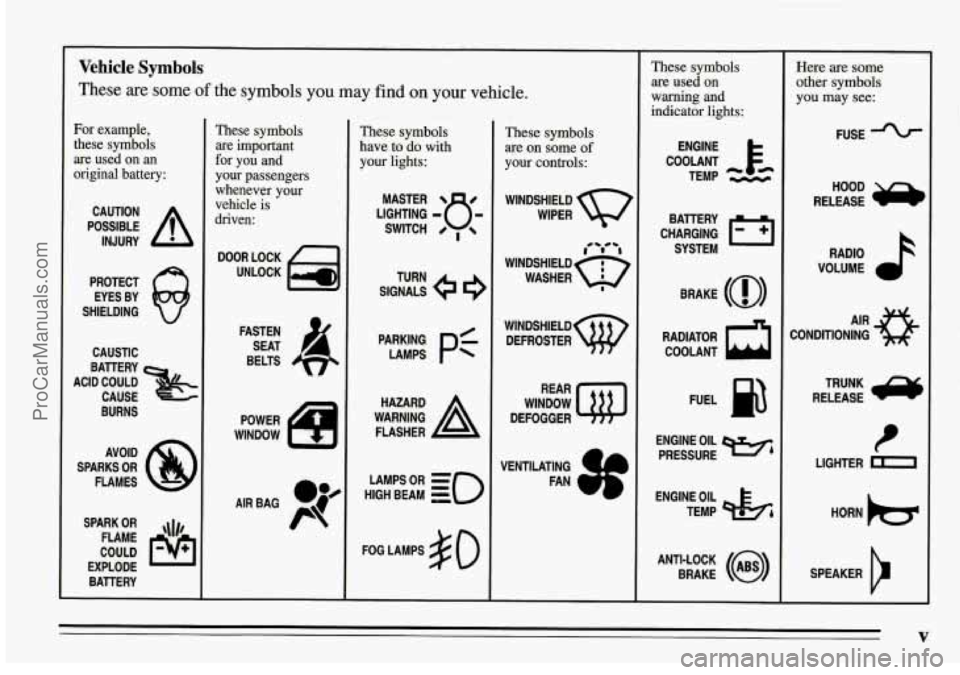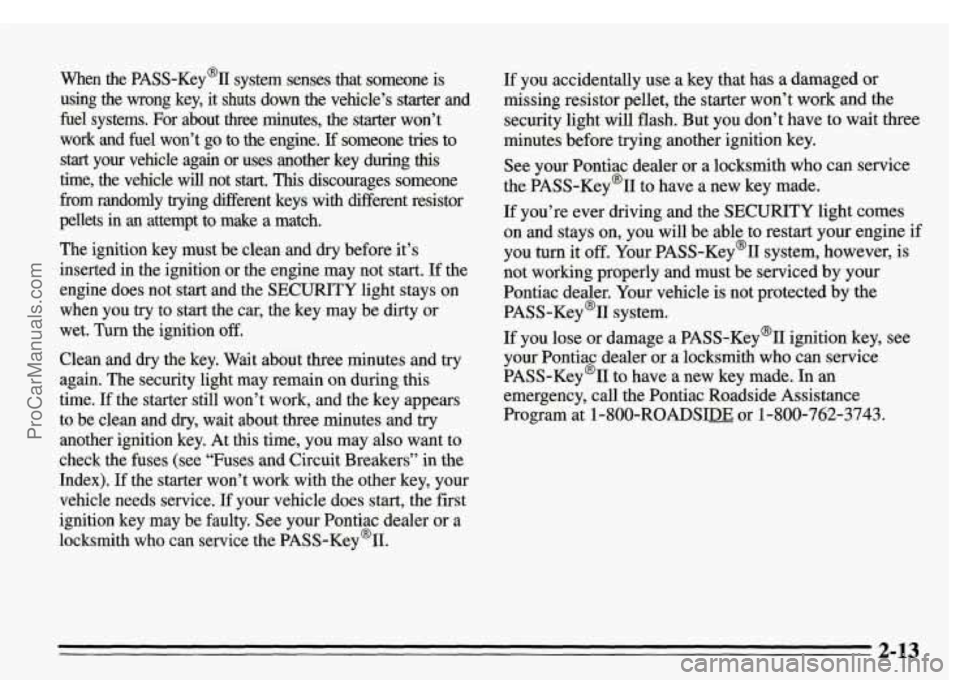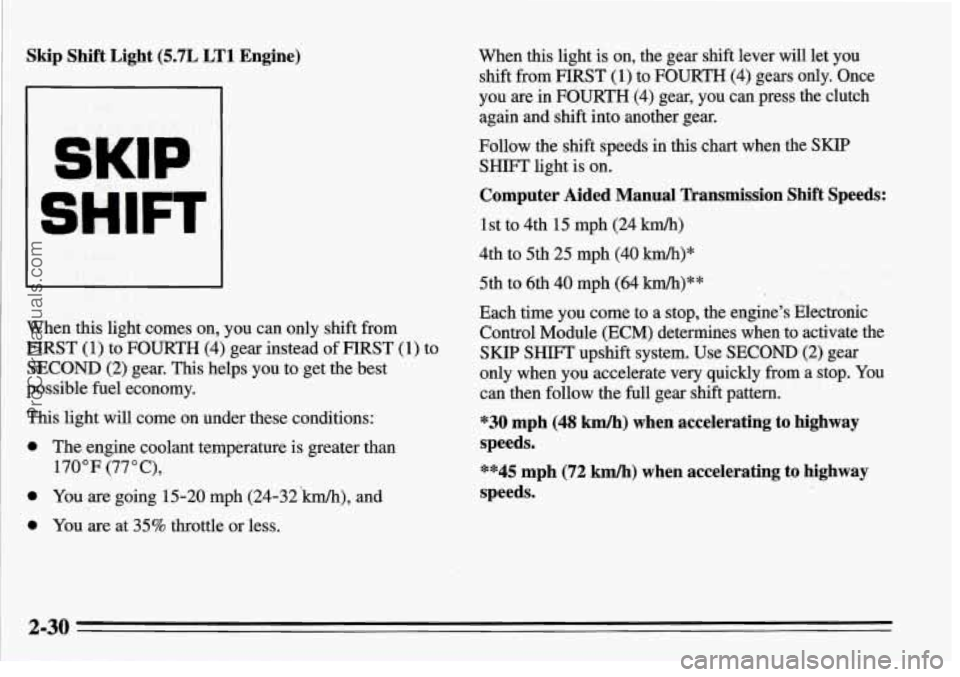light PONTIAC FIREBIRD 1995 Owners Manual
[x] Cancel search | Manufacturer: PONTIAC, Model Year: 1995, Model line: FIREBIRD, Model: PONTIAC FIREBIRD 1995Pages: 386, PDF Size: 19.66 MB
Page 6 of 386

Vehicle Symbols
These are some of the symbols you may find on your vehicle.
For example, these symbols
are used on an
original battery:
POSSIBLE A
CAUTION
INJURY
PROTECT EYES BY
SHIELDING
CAUSTIC
BURNS
AVOID
SPARKS
OR
FLAMES
SPARK OR ,\I/,
COULD FLAME
EXPLODE BAllERY
These symbols
are important
for you and
your passengers
whenever your
vehicle is
driven:
FASTEN SEAT 4
BELTS
POWER
WINDOW
These symbols
have to
do with
your lights:
SIGNALS e
TURN
pAE: pf
HIGH LAMPSoR BEAM = =o
FOG LAMPS $0
These symbols are on some
of
your controls:
WINDSHIELD
WIPER
i ‘t’ i
WINDSHIELD Q
WASHER I
WINDSHIELD
DEFROSTER
WINDOW
DEFOGGER
VENTILATING FAN
These symbols
are used on
warning and
indicator lights:
COOLANT F*
TEMP --
ENGINE
CHARGING 1-1
BATTERY
SYSTEM
BRAKE (0)
RADIATOR COOLANT
a
FUEL
ENGINE OIL
PRESSURE
9%
TEMP OIL &
ANTI-LOCK (a)
BRAKE
-
Here are some
other symbols
you may see:
FUSE
RAM0 h
VOLUME
CONDITIONING AIR 43
RELEASE a
LIGHTER m
SPEAKER
b
V
ProCarManuals.com
Page 15 of 386

Safety Belts: They’re for Everyone
This part of the manual tells you how to use safety belts
properly. It also tells you some things you should not do
with safety belts.
And it explains the Supplemental Inflatable Restraint, or
“air bag” system.
Your car has a light that comes on as a reminder to buckle
up.
(See “Safety Belt Reminder Light” in the Index.)
In many states and Canadian provinces, the law says to
wear safety belts. Here’s why:
They work.
You never know if you’ll be in a crash. If you do have a
crash, you don’t
know if it will be a bad one.
A few crashes are mild, and some crashes can be so
serious that even buckled up a person wouldn’t survive.
But most crashes are
in between. In many of them, people
who buckle up can survive and sometimes
walk away.
Without belts they could have been badly
hurt or killed.
After more than 25 years of safety belts in vehicles, the
facts are clear. In most crashes buckling up does matter
... a lot!
ProCarManuals.com
Page 20 of 386

How to Wear Safety Belts Properly
Adults
This part is only for people of adult size.
Be aware that there are special things to know about safety belts and children. And there are different rules
for smaller children and babies.
If a child will be riding
in your Pontiac, see the part of this manual called
“Children.” Follow those rules for everyone’s
protection.
First, you’ll want to know which restraint systems your
vehicle has.
We’ll start with the driver position.
Driver Position
This part describes the driver’s restraint system.
Lap-Shoulder Belt
The driver has a lap-shoulder belt. Here’s how to wear it
properly.
1. Close and lock the door.
2. Adjust the seat (to see how, see “Seats” in the Index)
so you can sit up straight.
3. Pick up the latch plate and pull the belt across you,
Don’t let it. get twisted.
On convertible models, the shoulder belt may lock if
you pull the belt across YOU very quickly, If this
happas, kt the belt go back slightly to unlock it.
Then pull the belt across you more slowly.
4. Push the latch plate into the buckle until it clicks.
1-13
ProCarManuals.com
Page 28 of 386

AIR
1 There is an air bag
readiness light on the
instrument panel,
which
shows “AIR
BAG” on it.
The system checks the air bag’s electrical system for
malfunctions. The light tells you if there is an electrical
problem. See “Air Bag Readiness Light” in the Index for more information.
How the Air Bag System Works
ProCarManuals.com
Page 33 of 386

The best way to protect the fetus is to protect the
mother. When a safety belt is worn properly, it’s more
likely that the fetus won’t be hurt in a crash.
For
pregnant women, as for anyone, the key to making
safety belts effective is wearing them properly.
Right Front Passenger PQsition
The right front passenger’s safety belt works the same
way as the driver’s safety belt. See “Driver Position,”
earlier in this section.
Rear Seat Passengers
It’s very important for rear seat passengers to buckle up!
Accident statistics show that unbelted people
in the rear
seat are hurt more often in crashes than those who are
wearing safety belts.
Rear passengers who aren’t safety belted can be
out of the vehicle in a crash. And they can strike
in the vehicle who are wearing safety belts. thrown
~ others
Lap-Shoulder Belt
The rear seats have lap-shoulder belts. Here’s how to
wear one properly.
1. Pick uu the latch plate and pull the belt across you.
Don’t let it get twisted.
On convertible models, the shoulder belt may lock if
you pull the belt across you very quickly. If this
happens, let the belt go back slightly to unlock it.
Then pull the belt across you more slowly.
ProCarManuals.com
Page 59 of 386

parking at Night
Park in a lighted spot, close all windows and lock your
vehicle. Remember
to keep you valuables out of sight.
Put them in a Storage area, or take them with you.
Parking Lots
If you park id a lot where someone will be watching
your vehicle, it's best to lock it up and
take your keys.
But what if you have to leave your ignition key? What if
you have to leave something valuable
in your vehicle?
ht your valdables in a storage area, like your glove
6 Lock the glove box.
0 Lock id1 the doors except the driver's.
Then
&e the door key with you.
bbx
PASS-Key@II
r
Your vehicle is equipped with the PASS-Key@%
(Personalized Automotive Security System) theft
deterrent system. PASS-Key% is a passive theft
deterrent system.
This means you don't have to do
anything different to arm or disarm the system. It works
when you insert or remove the key from the ignition.
PASS-Key% uses
a resistor pellet in the ignition key
that matches a decoder in your vehicle.
ProCarManuals.com
Page 60 of 386

When the PASS-Key(% system senses that someone is
using the wrong key, it shuts down the vehicle’s starter and
fuel systems. For about
three minutes, the starter won’t
work and fuel won’t
go to the engine. If someone tries to
start your vehicle again or uses another key during this
time, the vehicle will not start. This discourages someone
from randomly
trying different keys with different resistor
pellets in
an attempt to make a match.
The ignition key must be clean and dry before it’s
inserted in the ignition or the engine may not start. If the
engine does not start and the
SECURITY light stays on
when you
try to start the car, the key may be dirty or
wet.
Turn the ignition off.
Clean and dry the key. Wait about three minutes and try
again. The security light may remain on during this
time. If the starter still won’t work, and the key appears
to be clean
and dry, wait about three minutes and try
another ignition key. At this time, you may also want to
check the fuses (see “Fuses and Circuit Breakers” in the
Index).
If the starter won’t work with the other key, your
vehicle needs service.
If your vehicle does start, the first
ignition key may be faulty. See your Pontiac dealer or a
locksmith who can service the PASS-Key%.
If you accidentally use a key that has a damaged or
missing resistor pellet, the starter won’t work and the
security light will flash. But you don’t have to wait three
minutes before trying another ignition key.
See your Pontiac dealer or a locksmith who can service
the PASS-Key% to have a new key made.
If you’re ever driving and the
SECURITY light comes
on and stays on, you will be able to restart
your engine if
you
turn it off. Your PASS-Key% system, however, is
not working properly and must be serviced by your
Pontiac dealer. Your vehicle is not protected by the
PASS-Key% system.
If you lose or damage a PASS-Key@II ignition key, see
your Pontiac dealer or a locksmith who can service
PASS-Key’II to have a new key made. In
an
emergency, call the Pontiac Roadside Assistance
Program at 1-800-ROADSIm or
1-800-762-3743.
2-13
ProCarManuals.com
Page 62 of 386

If you have an automatic transmission, the ignition
switch can’t be turned to
LOCK unless the shift lever is
in the PARK (P) position.
OFF (C): Unlocks the steering wheel, ignition and
automatic transmission, but does not send electrical
power to
any accessories. Use this position if your
vehicle must be pushed or towed.
A warning tone will
sound if you open the driver’s door when the ignition is
OFF and the key is in the ignition.
RUN (D): Position to which the switch returns after you
start your engine and release the switch. The switch
stays in the
RUN position when the engine is running.
But even when the engine is not running, you can use
RUN to operate your electrical power accessories and to
display some instrument panel warning and indicator
lights.
START (E): Starts the engine. When the engine starts,
release the key. The ignition switch will return to
RUN
for normal driving.
Note that even if the engine is not running, ACC and
RUN allow you to operate your electrical accessories,
such as the radio and ventilation fan.
Key Release Button: If you have a manual
transmission, your ignition lock has
a key release button.
You must press the button before you can take: your key
out
of the ignition lock.
2-15
ProCarManuals.com
Page 67 of 386

Driving Through Deep Standing
Water
,*
NOTICE:
If you drive too quickly through deep puddles or
standing water, water can come in through your
engine’s air intake and badly damage your
engine. Never drive through water that is slightly
lower than the underbody
of your vehicle. If you
can’t avoid deep puddles or standing waiter, drive
through them very slowly.
Performance Mode Switch
This switch lets you change from a normal driving mode
to a performance mode. When you start the engine, the
switch will be in normal mode. For general driving
conditions, use
the normal mode. It will remain in
normal unless you select the PERFORM feature.
For a firmer shift and increased performance, you may
choose the
PERFORM mode. The light in the center of
the switch will light
up when selected. The switch will
then remain in performance mode until the engine
is
shut off, when it will go back to normal mode.
ProCarManuals.com
Page 77 of 386

Skip Shift Light (5.7L LTl Engine)
When this light comes on, you can only shift from
FIRST (1) to FOURTH (4) gear instead
of FIRST (1) to
SECOND (2) gear. This helps you to get the best
possible fuel economy.
This light will come on under these conditions:
0 The engine coolant temperature is greater than
170°F (77"C),
0 You are going 15-20 mph (24-32.'km/h), and
0 You are at 35% throttle or less.
When this light is on, the gear shift lever will let you
shift from
FIRST (1) to FOURTH (4) gears only. Once
you are in FOURTH (4) gear, you can press the clutch
again and shift into another gear.
Follow the shift speeds in this chart when the SKIP
SHIFT light is on.
Computer Aided Manual Transmission Shift Speeds:
1st to 4th 15 mph (24 km/h)
4th to 5th 25 mph (40 km/h)*
5th to 6th 40 mph (64 km/h)**
Each time you come to a stop, the engine's Electronic
Control Module (ECM) determines when to activate the
SKIP SHIFT upshift system. Use SECOND (2) gear
only when you accelerate very quickly from
a stop. You
can then follow the
full gear shift pattern.
"30 mph (48 km/h) when accelerating to highway
speeds.
**45 mph (72 krn/h) when accelerating to highway
speeds.
2-30
ProCarManuals.com